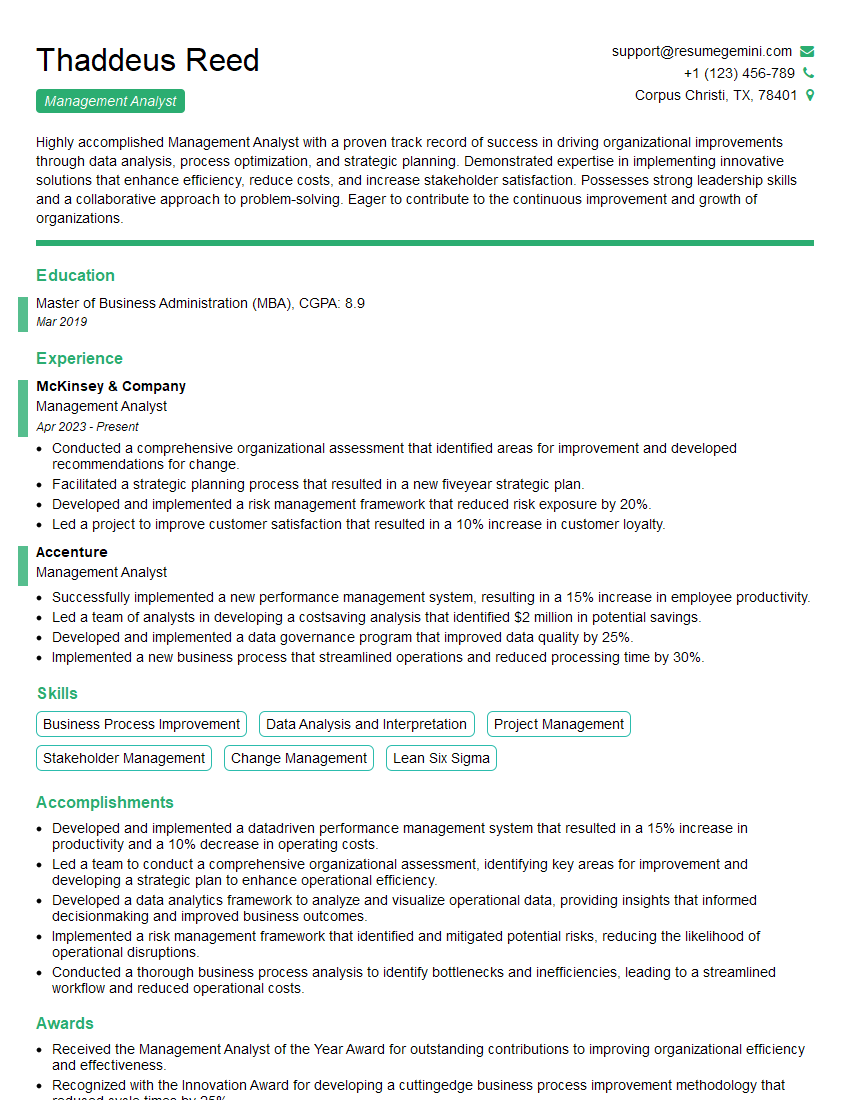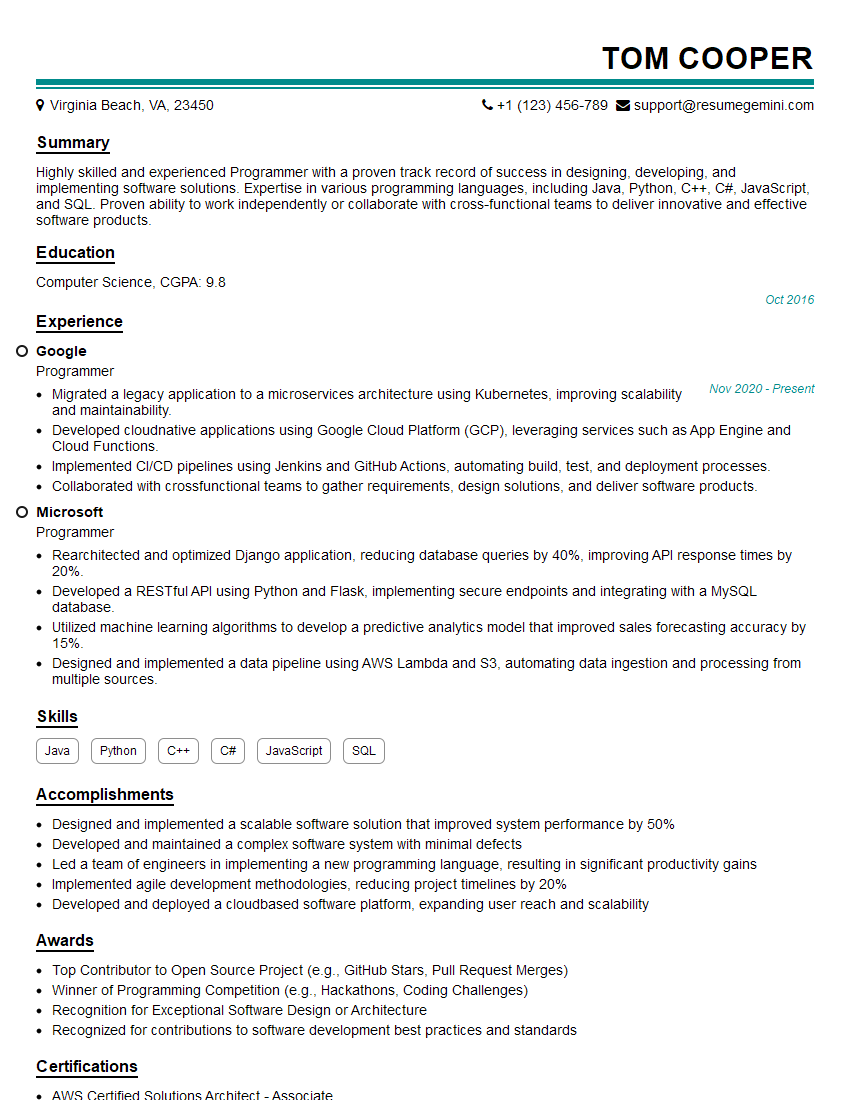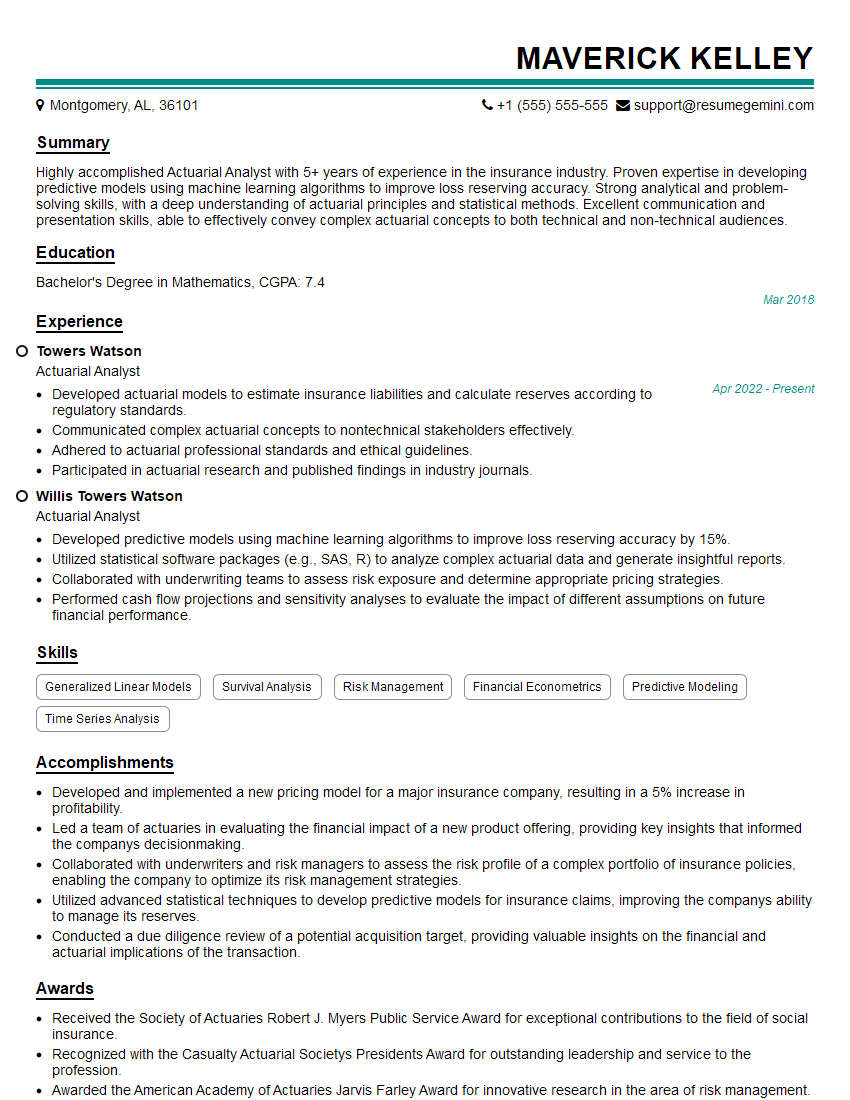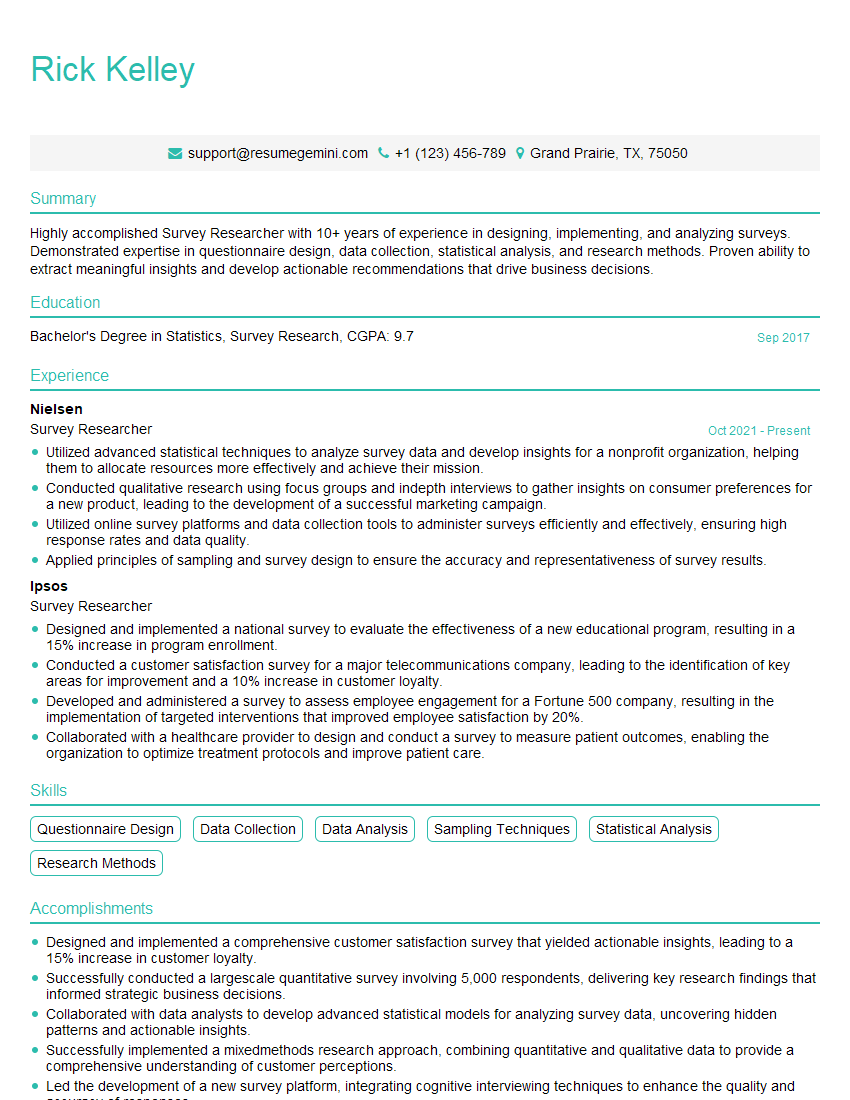Cracking a skill-specific interview, like one for Basic Mathematics and Calculation, requires understanding the nuances of the role. In this blog, we present the questions you’re most likely to encounter, along with insights into how to answer them effectively. Let’s ensure you’re ready to make a strong impression.
Questions Asked in Basic Mathematics and Calculation Interview
Q 1. What is the order of operations (PEMDAS/BODMAS)?
The order of operations, often remembered by the acronyms PEMDAS or BODMAS, dictates the sequence in which calculations should be performed in a mathematical expression. It ensures consistency and prevents ambiguity. PEMDAS stands for Parentheses/Brackets, Exponents/Orders, Multiplication and Division (from left to right), and Addition and Subtraction (from left to right). BODMAS uses Brackets, Orders, Division and Multiplication, Addition and Subtraction, representing the same order.
- Parentheses/Brackets: Solve expressions within parentheses or brackets first. This ensures that operations within these groupings are completed before anything else.
- Exponents/Orders: Calculate any exponents (powers or indices) next.
- Multiplication and Division: Perform multiplication and division operations from left to right, as they have equal precedence.
- Addition and Subtraction: Finally, perform addition and subtraction operations from left to right, again with equal precedence.
Example: Consider the expression 10 + 5 × 2² - (3 + 1). Following PEMDAS/BODMAS:
(3 + 1) = 42² = 45 × 4 = 2010 + 20 - 4 = 26
Therefore, the result of the expression is 26.
Q 2. Solve for x: 2x + 5 = 11
To solve for x in the equation 2x + 5 = 11, we need to isolate x on one side of the equation. We achieve this by performing inverse operations.
- Subtract 5 from both sides:
2x + 5 - 5 = 11 - 5, simplifying to2x = 6 - Divide both sides by 2:
2x / 2 = 6 / 2, resulting inx = 3
Therefore, the solution to the equation is x = 3. We can check this by substituting x = 3 back into the original equation: 2(3) + 5 = 6 + 5 = 11, which is correct.
Q 3. What is the formula for calculating the area of a circle?
The formula for calculating the area of a circle is A = πr², where:
Arepresents the area of the circle.π(pi) is a mathematical constant, approximately equal to 3.14159.rrepresents the radius of the circle (the distance from the center of the circle to any point on the circle).
This formula means that the area is proportional to the square of the radius. Doubling the radius quadruples the area of the circle. Imagine you’re making pizzas – a larger pizza (bigger radius) needs significantly more dough (area).
Q 4. Calculate the percentage increase from 50 to 75.
To calculate the percentage increase from 50 to 75, we first find the difference between the two numbers, then express that difference as a percentage of the original number.
- Find the difference:
75 - 50 = 25 - Divide the difference by the original number:
25 / 50 = 0.5 - Multiply by 100 to express as a percentage:
0.5 × 100 = 50%
Therefore, there is a 50% increase from 50 to 75.
Q 5. What is the difference between mean, median, and mode?
Mean, median, and mode are all measures of central tendency, describing the ‘middle’ of a dataset, but they do so in different ways.
- Mean: This is the average. Calculate it by summing all the values in the dataset and dividing by the number of values. Think of it as ‘fairly’ distributing the total amongst the values.
- Median: This is the middle value when the data is arranged in ascending order. If there’s an even number of values, the median is the average of the two middle values. It’s less sensitive to extreme values (outliers) than the mean.
- Mode: This is the value that appears most frequently in the dataset. A dataset can have one mode, multiple modes (multimodal), or no mode at all.
Example: Consider the dataset {2, 4, 4, 6, 8}. The mean is (2+4+4+6+8)/5 = 4.8. The median is 4. The mode is 4.
Q 6. How do you calculate simple interest?
Simple interest is calculated on the principal amount only. It doesn’t compound (meaning interest earned isn’t added back to the principal to earn more interest).
The formula for simple interest is: Simple Interest = (P × R × T) / 100
Prepresents the principal amount (the initial amount of money).Rrepresents the annual interest rate (expressed as a percentage).Trepresents the time period (in years).
Example: If you invest $1000 (P) at an annual interest rate of 5% (R) for 3 years (T), the simple interest earned would be: (1000 × 5 × 3) / 100 = $150
Q 7. How do you calculate compound interest?
Compound interest calculates interest not only on the principal amount but also on the accumulated interest from previous periods. This means your money grows faster over time.
The formula for compound interest is: A = P (1 + R/n)^(nT)
Ais the future value of the investment/loan, including interest.Pis the principal amount.Ris the annual interest rate (decimal).nis the number of times that interest is compounded per year.Tis the number of years the money is invested or borrowed for.
Example: If you invest $1000 at 5% annual interest compounded annually (n=1) for 3 years, the future value would be: A = 1000 (1 + 0.05/1)^(1×3) = 1000 (1.05)^3 ≈ $1157.63. Note that this is higher than the simple interest example due to the compounding effect.
Q 8. Explain the concept of ratio and proportion.
A ratio is a comparison of two or more quantities. It shows the relative sizes of the quantities. We often express ratios using a colon (:) or as a fraction. For example, if a recipe calls for 2 cups of flour and 1 cup of sugar, the ratio of flour to sugar is 2:1 or 2/1. A proportion is a statement that two ratios are equal. It’s essentially an equation involving ratios. For instance, 2/1 = 4/2 is a proportion because both ratios simplify to 2.
Think of ratios like comparing ingredients in a recipe or the dimensions of a photograph. Proportions are crucial in scaling, ensuring similar shapes maintain their relative sizes. For example, if you want to enlarge a picture while keeping its aspect ratio, you’d use proportions to calculate the new dimensions.
Example: If a car travels 100 miles in 2 hours, the ratio of miles to hours is 100:2 or 50:1. This means the car’s average speed is 50 miles per hour. If the car maintains this speed, a proportion would help calculate how far it travels in 3 hours: 50/1 = x/3. Solving for x gives us 150 miles.
Q 9. Solve the equation: 3(x – 2) = 9
To solve the equation 3(x - 2) = 9, we follow these steps:
- Distribute the 3: Multiply 3 by both terms inside the parentheses:
3x - 6 = 9 - Add 6 to both sides: This isolates the term with ‘x’:
3x = 15 - Divide both sides by 3: This solves for ‘x’:
x = 5
Therefore, the solution to the equation is x = 5. You can verify this by substituting 5 back into the original equation: 3(5 - 2) = 3(3) = 9, which is true.
Q 10. What is the Pythagorean theorem?
The Pythagorean theorem is a fundamental concept in geometry relating to right-angled triangles. It states that the square of the hypotenuse (the side opposite the right angle) is equal to the sum of the squares of the other two sides (called legs or cathetus).
Mathematically, it’s represented as a² + b² = c², where ‘a’ and ‘b’ are the lengths of the legs, and ‘c’ is the length of the hypotenuse.
This theorem has countless applications in fields like construction, surveying, navigation, and even computer graphics. Imagine building a right-angled wall – you can use the Pythagorean theorem to ensure it’s perfectly square.
Example: If a right-angled triangle has legs of length 3 and 4, the hypotenuse can be calculated as follows: 3² + 4² = c², which simplifies to 9 + 16 = c², so c² = 25, and therefore c = 5.
Q 11. What are the different types of fractions?
Fractions represent parts of a whole. Several types exist:
- Proper Fractions: The numerator (top number) is smaller than the denominator (bottom number). Example:
1/2 - Improper Fractions: The numerator is greater than or equal to the denominator. Example:
5/3 - Mixed Numbers: A combination of a whole number and a proper fraction. Example:
1 2/3(this is equivalent to the improper fraction 5/3) - Equivalent Fractions: Fractions that represent the same value, like
1/2and2/4
Understanding different fraction types is essential for performing arithmetic operations correctly and simplifying expressions. Improper fractions are often converted to mixed numbers for easier interpretation in real-world contexts.
Q 12. How do you convert a fraction to a decimal?
To convert a fraction to a decimal, you simply divide the numerator by the denominator.
Example: To convert the fraction 3/4 to a decimal, divide 3 by 4: 3 ÷ 4 = 0.75. Another example: 2/5 = 2 ÷ 5 = 0.4
If the division results in a non-terminating decimal (a decimal that goes on forever without repeating), you can round it to a specific number of decimal places depending on the required level of accuracy.
Q 13. How do you convert a decimal to a percentage?
To convert a decimal to a percentage, multiply the decimal by 100 and add a percent sign (%).
Example: To convert the decimal 0.75 to a percentage, multiply by 100: 0.75 × 100 = 75%. Similarly, 0.4 × 100 = 40%.
Percentages are widely used to express proportions or rates, such as discounts, interest rates, or survey results. Converting between decimals and percentages is a critical skill in various fields, including finance and statistics.
Q 14. What are the properties of exponents?
Exponents (also called powers or indices) indicate repeated multiplication. For example, x³ means x × x × x. Key properties include:
- Product of Powers:
xᵃ × xᵇ = x⁽ᵃ⁺ᵇ⁾(When multiplying terms with the same base, add the exponents) - Quotient of Powers:
xᵃ / xᵇ = x⁽ᵃ⁻ᵇ⁾(When dividing terms with the same base, subtract the exponents) - Power of a Power:
(xᵃ)ᵇ = x⁽ᵃˣᵇ⁾(When raising a power to another power, multiply the exponents) - Power of a Product:
(xy)ᵃ = xᵃyᵃ(When raising a product to a power, raise each factor to that power) - Power of a Quotient:
(x/y)ᵃ = xᵃ/yᵃ(When raising a quotient to a power, raise both the numerator and denominator to that power) - Zero Exponent:
x⁰ = 1(Any non-zero number raised to the power of 0 is 1) - Negative Exponent:
x⁻ᵃ = 1/xᵃ(A negative exponent indicates the reciprocal)
Understanding these properties is crucial for simplifying algebraic expressions and solving equations involving exponents. They are fundamental in calculus, physics, and many other fields.
Q 15. Solve for x: x² = 25
Solving the equation x² = 25 involves finding the values of x that, when squared, equal 25. We can achieve this by taking the square root of both sides of the equation. Remember that a positive number has two square roots – one positive and one negative.
Therefore, the square root of 25 is both +5 and -5. So, x = ±5. This means there are two solutions: x = 5 and x = -5. You can verify this by substituting these values back into the original equation: 5² = 25 and (-5)² = 25, both statements are true.
Career Expert Tips:
- Ace those interviews! Prepare effectively by reviewing the Top 50 Most Common Interview Questions on ResumeGemini.
- Navigate your job search with confidence! Explore a wide range of Career Tips on ResumeGemini. Learn about common challenges and recommendations to overcome them.
- Craft the perfect resume! Master the Art of Resume Writing with ResumeGemini’s guide. Showcase your unique qualifications and achievements effectively.
- Don’t miss out on holiday savings! Build your dream resume with ResumeGemini’s ATS optimized templates.
Q 16. What is the formula for calculating the volume of a cube?
The volume of a cube is calculated by multiplying its side length by itself three times (cubing the side length). Imagine a cube as a stack of square layers. Each layer has a volume equal to the side length squared (area), and the total volume is found by multiplying this area by the number of layers (the side length).
The formula is: Volume = side³ or V = s³, where ‘s’ represents the length of one side of the cube.
For example, if a cube has sides of length 3 cm, its volume would be 3³ = 27 cubic centimeters.
Q 17. What is the formula for calculating the volume of a sphere?
Calculating the volume of a sphere involves using a slightly more complex formula. The formula is derived from integral calculus, but you don’t need to understand calculus to use it. Imagine trying to fill a sphere with tiny cubes – it would be tricky to get a perfect fit! The formula accounts for all the curves and irregularities.
The formula for the volume of a sphere is: Volume = (4/3)πr³, where ‘r’ represents the radius of the sphere (the distance from the center to the edge) and ‘π’ (pi) is approximately 3.14159.
For example, a sphere with a radius of 2 meters would have a volume of approximately (4/3) * 3.14159 * 2³ ≈ 33.51 cubic meters.
Q 18. Explain the concept of probability.
Probability is a measure of the likelihood of an event occurring. It’s expressed as a number between 0 and 1, inclusive. A probability of 0 means the event is impossible, while a probability of 1 means the event is certain. Probabilities often involve fractions or percentages.
For instance, if you flip a fair coin, the probability of getting heads is 0.5 (or 50%), because there are two equally likely outcomes (heads or tails). The probability of rolling a specific number (e.g., a 3) on a six-sided die is 1/6, as there are six equally likely outcomes.
Understanding probability is crucial in various fields, from weather forecasting and finance to medical diagnosis and quality control.
Q 19. What is the difference between a histogram and a bar chart?
Histograms and bar charts are both used to visualize data, but they differ in what they represent. A bar chart compares different categories or groups. The length of each bar represents the frequency or value of each category. Categories are distinct and not necessarily numerical.
A histogram, on the other hand, displays the distribution of numerical data. It shows the frequency of data points falling within specific ranges or intervals (bins). The bars in a histogram touch each other because the intervals represent a continuous range of data.
Imagine comparing the number of cars of different makes sold in a year (bar chart) versus showing the distribution of student exam scores across different score ranges (histogram).
Q 20. How do you calculate the average of a set of numbers?
The average (also called the mean) of a set of numbers is calculated by summing all the numbers in the set and then dividing by the total count of numbers in the set. This gives you a central tendency representing the typical value of the dataset.
For example, to find the average of the numbers 2, 4, 6, and 8: (2 + 4 + 6 + 8) / 4 = 5. The average of this set is 5.
Averages are widely used in everyday life and professional settings, from calculating grades to determining average income or analyzing sales figures.
Q 21. What is the concept of standard deviation?
Standard deviation measures the spread or dispersion of a dataset around its mean (average). A low standard deviation indicates that the data points are clustered closely around the mean, while a high standard deviation signifies that the data is more spread out.
Imagine two sets of exam scores with the same average. One set might have scores tightly clustered around the average, indicating low standard deviation, while the other might have scores widely scattered, indicating high standard deviation. This means the second set shows greater variability in performance.
Standard deviation is a critical concept in statistics and is used in finance, quality control, and many other fields to assess risk, variability and reliability of data. A large standard deviation suggests greater uncertainty or risk.
Q 22. How do you solve simultaneous equations?
Solving simultaneous equations involves finding the values of the variables that satisfy all equations in a given system. There are several methods, each with its strengths and weaknesses.
- Substitution: Solve one equation for one variable in terms of the other, then substitute this expression into the second equation. This simplifies the problem to a single equation with one variable.
- Elimination (or Addition/Subtraction): Multiply one or both equations by constants to make the coefficients of one variable opposites. Add the equations together to eliminate that variable, leaving a single equation with one variable to solve. Then, substitute the found value back into either original equation to find the other variable.
- Graphical Method: Plot the equations on a graph. The point where the lines intersect represents the solution (the x and y values at that point).
Example (Elimination):
Solve:
2x + y = 7x - y = 2Adding the two equations eliminates ‘y’: 3x = 9, so x = 3. Substituting x = 3 into either original equation gives y = 1. The solution is x = 3, y = 1.
Example (Substitution):
Solve:
y = x + 22x + y = 8Substitute ‘x + 2’ for ‘y’ in the second equation: 2x + (x + 2) = 8. This simplifies to 3x = 6, so x = 2. Substituting x = 2 into y = x + 2 gives y = 4. The solution is x = 2, y = 4.
Simultaneous equations are used extensively in various fields like engineering (analyzing circuits), economics (supply and demand), and computer science (solving linear programming problems).
Q 23. Explain the concept of linear equations.
A linear equation is an algebraic equation where each term is either a constant or the product of a constant and a single variable. The graph of a linear equation is always a straight line. The general form is typically written as y = mx + c, where:
yandxare the variables.mis the slope (representing the steepness of the line).cis the y-intercept (where the line crosses the y-axis).
Example: y = 2x + 3 is a linear equation with a slope of 2 and a y-intercept of 3.
Linear equations are fundamental in many applications. For instance, they model relationships between two quantities that change at a constant rate. Imagine calculating the cost of a taxi ride: the fare might be a fixed amount plus a charge per kilometer. This can be represented by a linear equation where the total cost (y) depends on the distance traveled (x).
Q 24. Solve for x: √x = 4
To solve for x in the equation √x = 4, we need to eliminate the square root. We can do this by squaring both sides of the equation:
(√x)² = 4²This simplifies to:
x = 16Therefore, the solution is x = 16. We can check this by substituting it back into the original equation: √16 = 4, which is true.
Q 25. How do you calculate the area of a triangle?
The area of a triangle is calculated using the formula:
Area = (1/2) * base * heightWhere ‘base’ is the length of any side of the triangle, and ‘height’ is the perpendicular distance from that side to the opposite vertex.
Example: A triangle has a base of 6 cm and a height of 4 cm. Its area is (1/2) * 6 cm * 4 cm = 12 cm².
This formula is widely used in surveying, construction, and design to calculate surface areas.
Q 26. What is the concept of logarithms?
Logarithms are the inverse operation of exponentiation. In simpler terms, a logarithm answers the question: “What exponent is needed to raise a base to get a specific number?”
The basic logarithmic equation is written as:
logb(x) = yThis is equivalent to the exponential equation:
by = xWhere:
bis the base (a positive number not equal to 1).xis the argument (a positive number).yis the logarithm (the exponent).
Example: log10(100) = 2 because 10² = 100.
Logarithms are crucial in various fields, including chemistry (pH calculations), physics (measuring sound intensity), and finance (compound interest calculations).
Q 27. Explain the difference between integers and real numbers.
Integers and real numbers are both number systems, but they differ significantly:
- Integers are whole numbers, including zero, and their negative counterparts. Examples: -3, -2, -1, 0, 1, 2, 3…
- Real numbers encompass all numbers on the number line, including integers, fractions, decimals, and irrational numbers (numbers that cannot be expressed as a simple fraction, like π or √2).
Essentially, integers are a subset of real numbers. All integers are real numbers, but not all real numbers are integers.
Q 28. How do you convert between different units of measurement (e.g., meters to kilometers)?
Converting between units of measurement involves using conversion factors. A conversion factor is a ratio that expresses the relationship between two units. The key is to set up the conversion so that the unwanted units cancel out, leaving you with the desired units.
Example: Converting meters to kilometers:
There are 1000 meters in 1 kilometer. To convert 2500 meters to kilometers, we set up the conversion as follows:
2500 meters * (1 kilometer / 1000 meters) = 2.5 kilometersNotice how the ‘meters’ units cancel out, leaving us with ‘kilometers’.
Similarly, you can convert other units. For example, to convert inches to centimeters, you would use the conversion factor 1 inch = 2.54 cm.
Unit conversion is fundamental in engineering, science, and many other professions where dealing with different measurement systems is common.
Key Topics to Learn for Basic Mathematics and Calculation Interview
- Arithmetic Operations: Mastering addition, subtraction, multiplication, and division, including working with fractions, decimals, and percentages. Understanding order of operations (PEMDAS/BODMAS) is crucial.
- Algebraic Concepts: Familiarize yourself with solving basic algebraic equations and inequalities. Practice working with variables, simplifying expressions, and understanding linear equations.
- Ratio and Proportion: Understand the concepts of ratio and proportion and their applications in problem-solving. Practice solving problems involving direct and inverse proportions.
- Geometry and Measurement: Review basic geometric shapes, their properties, and formulas for calculating area, volume, and perimeter. Understand units of measurement and conversions.
- Data Interpretation: Practice interpreting data presented in tables, charts, and graphs. Develop skills in calculating averages, percentages, and identifying trends.
- Practical Applications: Consider how these mathematical concepts are applied in real-world scenarios relevant to your field. For example, how might you use ratios in a budgeting scenario or algebra in a data analysis task?
- Problem-Solving Strategies: Develop a systematic approach to solving mathematical problems. Practice breaking down complex problems into smaller, manageable steps.
Next Steps
Mastering basic mathematics and calculation is fundamental for success in many roles, demonstrating analytical skills and problem-solving abilities highly valued by employers. A strong foundation in these areas can significantly boost your career prospects and open doors to exciting opportunities. To make your application stand out, crafting an ATS-friendly resume is essential. ResumeGemini can help you build a professional and effective resume that highlights your skills and experience. We offer examples of resumes tailored to candidates with expertise in Basic Mathematics and Calculation to help you get started.
Explore more articles
Users Rating of Our Blogs
Share Your Experience
We value your feedback! Please rate our content and share your thoughts (optional).
What Readers Say About Our Blog
Hello,
We found issues with your domain’s email setup that may be sending your messages to spam or blocking them completely. InboxShield Mini shows you how to fix it in minutes — no tech skills required.
Scan your domain now for details: https://inboxshield-mini.com/
— Adam @ InboxShield Mini
Reply STOP to unsubscribe
Hi, are you owner of interviewgemini.com? What if I told you I could help you find extra time in your schedule, reconnect with leads you didn’t even realize you missed, and bring in more “I want to work with you” conversations, without increasing your ad spend or hiring a full-time employee?
All with a flexible, budget-friendly service that could easily pay for itself. Sounds good?
Would it be nice to jump on a quick 10-minute call so I can show you exactly how we make this work?
Best,
Hapei
Marketing Director
Hey, I know you’re the owner of interviewgemini.com. I’ll be quick.
Fundraising for your business is tough and time-consuming. We make it easier by guaranteeing two private investor meetings each month, for six months. No demos, no pitch events – just direct introductions to active investors matched to your startup.
If youR17;re raising, this could help you build real momentum. Want me to send more info?
Hi, I represent an SEO company that specialises in getting you AI citations and higher rankings on Google. I’d like to offer you a 100% free SEO audit for your website. Would you be interested?
Hi, I represent an SEO company that specialises in getting you AI citations and higher rankings on Google. I’d like to offer you a 100% free SEO audit for your website. Would you be interested?
good
























